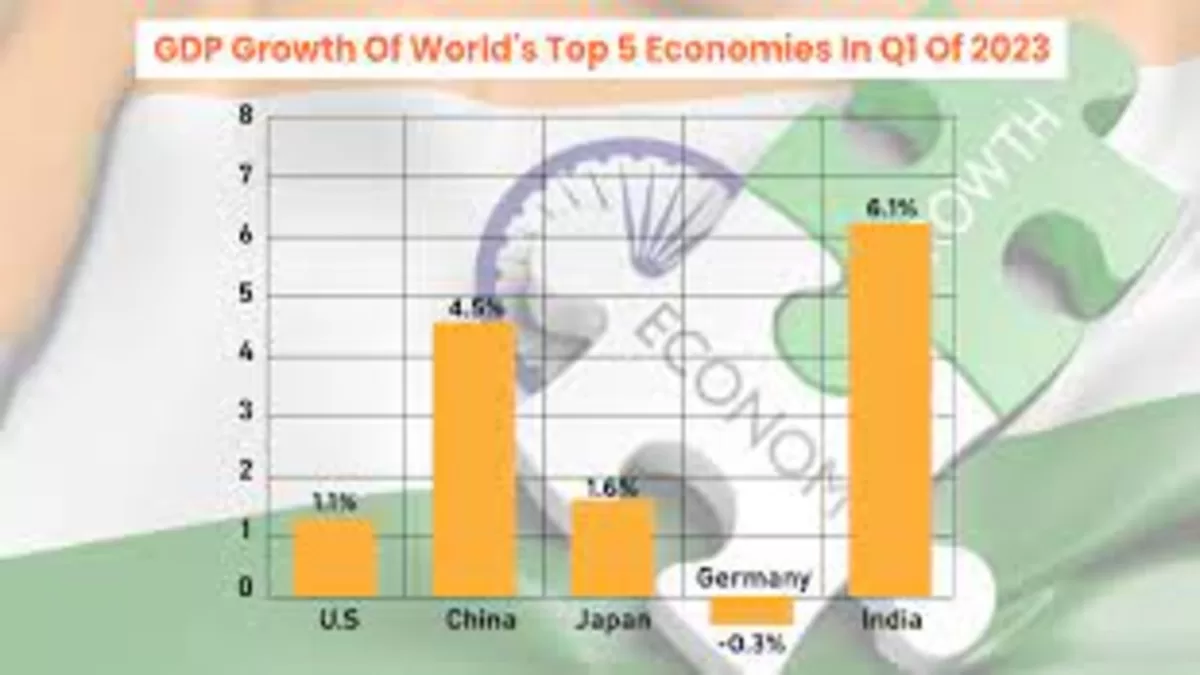India Emerges As The Fastest Growing Country Among World’s Top 5 Economies In Q1 Of 2023
Brief:
With a continuous 8% GDP growth rate over a 15-year period, India has the ability to surpass the United States as the largest economy. Its youthful and sizable population offers benefits including a strong workforce, increased savings, and the possibility for innovation. India must tackle issues like raising the workforce participation rate of women and raising educational standards in order to do this. For countries to continue experiencing high growth rates, trade protectionism must be reduced and globalization must be accepted. India’s economic prosperity depends on measures to extend economic liberalization, reform taxes, and implement privatization.
Introduction
India’s economy has a long history and formerly dominated the globe for an incredible amount of time. However, the United States and later China took the lead over time. But with the development of Asia and the quick economic expansion of countries like China and India, the issue today is if that country’s economy is ready to pass the US and reclaim its old glories.
The Indian economy was compared to the top four positions held by the world’s economic giants, notably the United States, China, Japan, and Germany, in a recent report published in Times magazine. These nations have constantly occupied key roles in the world economy, influencing the direction of international trade and business.
The rankings showcased in the analysis are as follows:
| Ranking | country | GDP in Billion $ |
| 1 | United States | 25,462.7 |
| 2 | China | 17,963.2 |
| 3 | Japan | 4,231.1 |
| 4 | Germany | 4,072.2 |
The rankings show how economically powerful these countries are currently, with the United States leading the pack and being followed by China, Japan, and Germany. India’s position stands out among these economic behemoths, though, because of its potential for exponential expansion and growing economic might.
Indian Economy’s Growth
The once-dominant economy of the world, India, has undergone transition. Over the ages, its economic environment saw enormous changes, and although briefly losing the top rank, it has been slowly improving.
According to renowned economist Angus Maddison, India had the greatest economy in the world for more than a millennium. China subsequently overtook India, although both countries continued to have the largest economies in the world up until the effects of the Industrial Revolution and European colonialism changed the face of the international economy. By 1900, the United States had become a global economic leader. China’s economy, which is now 70% of the size of the United States’ and is expanding quickly, is anticipated to surpass it between 2035 and 2040. Now, the real question is whether India will follow suit and pass the United States.
India’s Possibilities are Good
According to the report, China’s remarkable development trajectory is expected to elevate it to the title of having the largest economy in the world by 2035–2040. This event makes it unclear if India will continue on its present path and be able to overtake the United States as the world’s economic leader.
The good news for India is that, compared to the U.S.’s less than 2% growth rate, it maintained an exceptional 8% real GDP growth rate for 15 years prior to COVID-19. India may surpass the U.S. by 2073 if it maintains its current growth tendency for the following 20 years and grows at a rate of 5% while the U.S. grows at a pace of 2%.
Getting Close
India now has a GDP per capita that is less than 20% of China’s and 5% of the United States, which offers enormous development potential. Utilizing currently available, better technology, India can significantly enhance productivity by concentrating on capital accumulation and skill-building for its people.
Having a Young Population Has Benefits
India’s big and young population has a number of benefits. Younger workers produce more per worker, save more, invest more, and contribute to a more dynamic, creative country.

Taking Advantage of Population Size
The world’s most populated nation, India, just surpassed China, and this demographic advantage offers economies of scale for delivering public goods and services. A bigger user base significantly lowers the per-capita cost of supply chain management and infrastructure development.
Challenges
India has to concentrate on expanding women’s labor participation and enhancing education at all levels in order to fully realize the potential of its young population.
In addition, for sustainable prosperity, trade protectionism must be reduced and globalization must be accepted. India could think about reducing tariffs, creating free trade agreements, and using less anti-dumping safeguards. Swift Action Required
To enhance their performance, India must privatize several public sector organizations, notably banks. Prioritizing tax reform would help ensure that businesses have a fair and effective system.
Conclusion
India’s economic development has great promise and potential, to sum up. Its trajectory and growth prospects are worth attentively monitoring because it is one of the world’s leading economies. India has the ability to not only keep up with but even surpass the economic giants in the next decades by utilizing its population advantage, embracing reforms, and fostering a favorable business climate. India is on the verge of entering a transformational economic age as the world watches its rise.
FAQs (Frequently Asked Questions)
How long did India have the distinction of having the biggest economy ever?
For an astonishing one and a half millennia, India held the distinction.
When did China overtake India as the greatest economy on Earth?
In 1820, China overtook India.
What aspects of India’s economic development are favorable?
India advantages from having a youthful, huge population since it has a large labor force, larger savings, and innovation potential.
How can India move its economy closer to that of the United States?
India has to focus on tax reform, remove trade protectionism, and privatize certain public sector businesses.
In terms of economic size, when may India surpass the United States?
India might overtake the United States by 2073 if it maintains an 8% growth rate for the following 20 years and a 5% growth rate after that.
